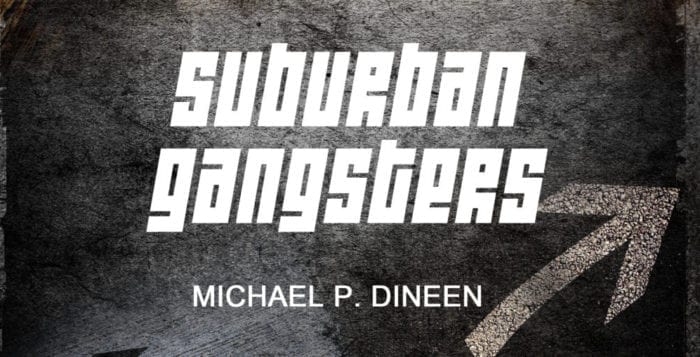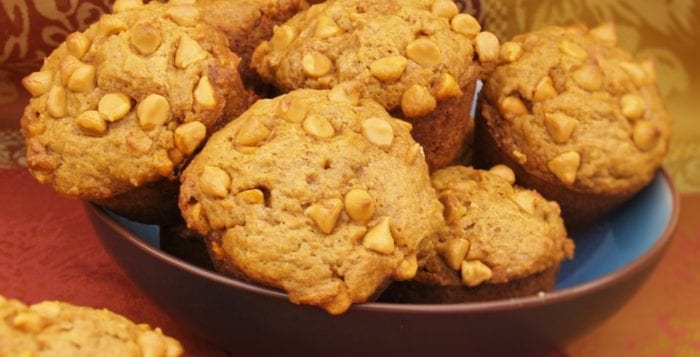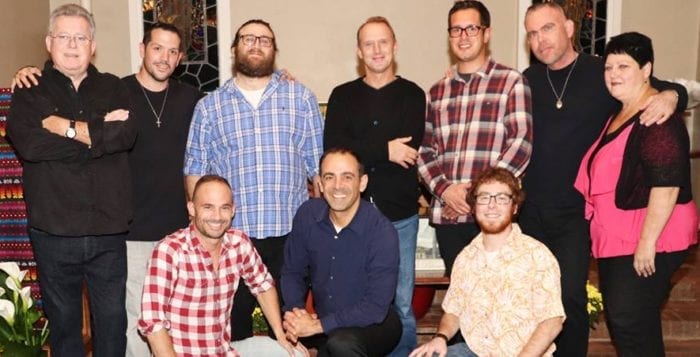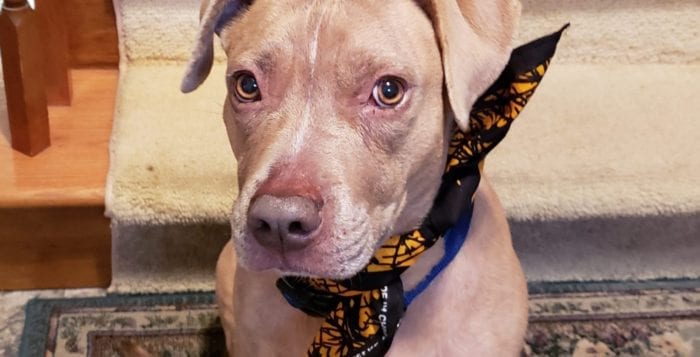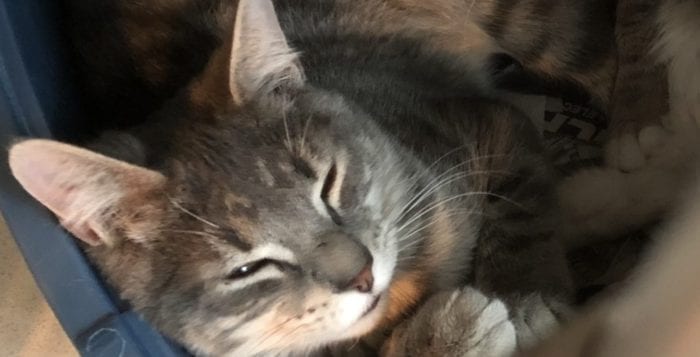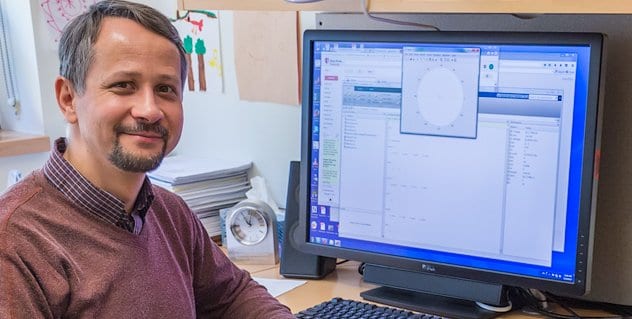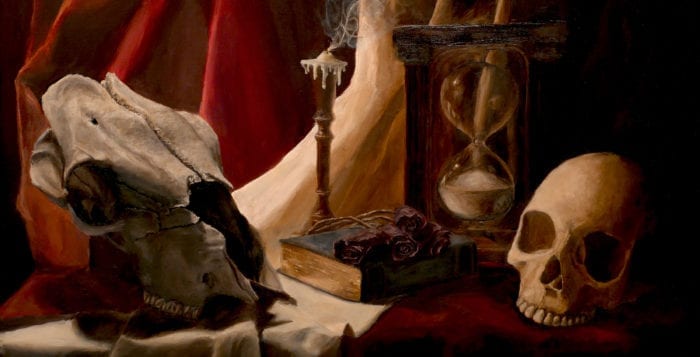Back by popular demand, the Resurrection Byzantine Catholic Church, 38 Mayflower Ave., Smithtown will host its annual Slavic Dinner on Saturday, Nov. 3 with two seatings: 4 and 6:30 p.m. accompanied by a performance by the Resurrection Ukrainian Folk Heritage Dancers, a cash bar, raffles and traditional ethnic boutique with handmade Pysanky eggs, crafts, gifts and more. $22 per person includes a Troika platter dinner of cucumber salad, kielbasa, pirogi, stuffed cabbage, homemade desserts, coffee and tea. For reservations, call Lisa at 631-265-6701. Walk-ins welcome.
Book Review: ‘Suburban Gangsters’
Reviewed by Jeffrey Sanzel
In his novel, “Suburban Gangsters,” Michael P. Dineen paints a bleak picture of the drug dealing/criminal culture on Long Island, spanning the 1980s right through the War on Drugs of the 2000s. And while Dineen is dealing with a difficult and often ugly story, he has managed to create an engaging and occasionally darkly humorous chronicle.
Clearly, the book is a fictional account of his own life, told first person through Huntington resident Patrick Hunter. While Hunter was born in New York City, he was raised on Long Island. And while his experience focuses mainly on the drug dealing issues that were faced locally, he tells a universal story.
Hunter is the son of a cold and demanding Army vet and New York City firefighter. He starts off as an athlete but strays from the path. He can trace the turning point to his father refusing to co-sign a car loan for him. “Had my conversation gone differently with my father in the spring of 1985, I may have never become a criminal.” By his junior year, it is this deep-seated anger with his father that turns this jock into a burnout and juvenile delinquent.
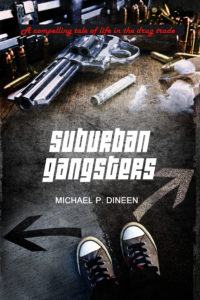
A combination of intense training and steroids also fuel his rage and anti-social behavior. He and his friends “trained like animals” in this hybrid martial art called American Combat Karate. His change in personality draws him to like-minded and like-feeling young people. He begins using cocaine and then successfully selling it. “I had no clue that we had just opened Pandora’s box.” This metaphor points to the perils that follow.
Dealing out of his home, Hunter could clear $5,000 to $10,000 a week. “For being average kids from the suburbs, that was serious dough. And we were just starting to scratch the surface of this modern-day gold rush.”
It’s not long before the enterprise begins to grow: “Settling into a nice routine, we began expanding the scope of our business. In addition to selling cocaine, we were now selling steroids, pain pills, other pharmaceuticals, and even small amounts of marijuana. And we also began some small loan sharking.”
Hunter gives an unflinching description of the toll that cocaine and crack cocaine have taken on the community. Throughout the book, there are devastating reports of destruction — both of people and property. (A wilding incident secures his gang’s creed but also called them to the police’s attention.) It is a brutal world where the anger and danger manifest in violent and senseless brawling. The only loyalty in this cutthroat existence is to money. There are many stories here of drug users that involve beatings and worse.
His life is populated with equally damaged souls. When he falls in love, drugs predictably complicate his life. His girlfriend (and later wife), Vanessa, is a cocaine user and later addicted to pain pills. He shows that there is no emotional security when dealing with an addict. Love may blur the problems but it won’t make them go away. His partner, Jake, is a study in contrast. Jake is a high risk-taker and that causes a much earlier fall than Hunter. Even those who are committed to him in their own way are a liability in this hard society.
The first shift is when dealers begin making deals with the police and FBI. As they begin to roll over, it becomes an era defined by survival. The narrative refrain is to “trust no one” as the likelihood is betrayal. His life alternates between dealing and partying and hiding and running.
Throughout the narrative, Hunter addresses issues of karma. The fact that he is the one who hooks Vanessa on Percodan (and eventually she goes back to cocaine) is just as much his fault as hers. There is the overall ruin that visits all who are involved. “When you are caught up in the hustle game making easy money, it’s almost impossible to voluntarily stop. It’s just as hard to stop dealing drugs, as it is to stop using drugs. Making that money becomes just as addictive.”
In addition to the drug world, there is theft. A gang called the Crash and Carry Gang are featured throughout. A highly dangerous crew that steals and fences, the intersection of Hunter and these men only furthers his twisted existence.
After a number of years, Hunter shifts his dealing to only selling marijuana and becoming a police informant. This gives both security and the ability to rat out the competition. He and his second partner, Big Ray, make a fortune while serving as police informants:
“We just finished a two-year run of basically being able to deal drugs with police protection. Our involvement with them and setting up that huge bust allowed us to operate while they looked the other way. It may sound crazy, but it’s true. Had you told me back in 1985 that seven years later I would still be dealing, only acting as a double agent by being a federal informant, I would have said you were nuts. But that is the insanity of this lifestyle. If you weren’t smart enough to roll with the changing times, you would have the life expectancy of a housefly.”
The fact is, by this time, everyone was either being caught or flipping. Everyone with whom Hunter had been involved was either cooperating or in jail.
Through all of this, glimmers of Hunter’s humanity come through. There is a poignant account of the death of a friend to heroin overdose (one of many in his journey).
His love for the daughter he has by Vanessa and his fear for her safety is also very honest. The devastating loss of his karate mentor coincides with the dissolution of his marriage.
And in 1998, Hunter gets hooked on painkillers. The final portion of the book, entitled “To Hell and Back,” is the ultimate karmic payback. He begins the section with an unflinching assessment of the opioid and heroin crises:
“The painful truth is no one seemed to care when heroin was devastating the inner city minority neighborhoods. Now that Little Johnny and Suzy from the bourgeoisie started dying, people finally started taking notice. That is politics for you. … For years, my fellow criminals and I cashed in on the suffering and unquenchable desire of a population that demanded drugs. It was almost like taking candy from a baby, it was so easy. But now the universe was about to flip the script and teach me a punishing lesson, you reap what you sow.”
While he began with a pill addiction, like so many, Hunter shifted to heroin because it was both cheaper and more accessible. His own downfall is inevitable:
“[H]eroin became the new love of my life. It was a total obsession for me. My habit became enormous overnight. Within a few weeks, I was sniffing twenty bags or two bundles a day. This continued for about three months until [his dealer] just up and disappeared. Now unable to get it, I began to panic. Withdrawal began creeping in and I was miserable.”
What ensues is a circle of detox, followed by relapse, methadone clinics, jail, homelessness … There is a harrowing observation that after 9/11, dopers thoughts were only how would they get their fix? And, of course, the question of how did he get here haunts him: He went from a million dollar drug business to being a junkie with nothing to his name. It is not until 2008 that Hunter is finally drug free and has his life on track.
In the beginning, Dineen writes with wonder at his often good luck … and later is accepting of his ultimate fate. In the end, he reaches both a sense of self and responsibility. His final thought is an important warning:
“So let this be a cautionary tale to anyone who is thinking about embarking on a life of crime or being involved with narcotics. There is no riding off into the sunset, no Hollywood endings when it comes to drug and crime. You will be lucky to escape with your freedom, and most importantly, your life!”
“Suburban Gangsters” by Michael P. Dineen is available online at Amazon.com or from its distributor AT www.dorrancepublishing.com.
Cooking Cove: An inside story on jack-o’-lanterns
By Barbara Beltrami
When the kids were little, we used to carve pumpkins and then use the insides to make all kinds of pumpkin goodies: pumpkin bread, which we froze for Thanksgiving; pumpkin soup and pie and pudding; and cookies and cakes. Each year we would try a new recipe for the jack-o’-lantern’s innards; sometimes it was great like the pumpkin-butterscotch muffins and sometimes it was awful like the pumpkin tapioca. But we always had fun looking up recipes and concocting something new. Here are two of our success stories.
Pumpkin-Butterscotch Muffins

YIELD: Makes 10 to 12 muffins
INGREDIENTS:
½ cup sugar
¼ cup brown sugar
¼ cup vegetable oil
2 eggs
¾ cup pureed cooked fresh pumpkin, drained
¼ cup water
1¼ cups flour
¼ cup whole wheat flour
¾ teaspoon baking powder
½ teaspoon baking soda
¼ teaspoon ground cinnamon
¼ teaspoon salt
¼ teaspoon ground nutmeg
2/3 cup butterscotch morsels
DIRECTIONS:
Preheat oven to 400 F. Grease a muffin pan or insert paper liners. In a medium bowl, combine sugars, oil and eggs. Stir in pumpkin and water. In a large bowl, sift together the flours, baking powder, baking soda, cinnamon, salt and nutmeg. Add the pumpkin mixture and butterscotch morsels; stir until just combined. Do not overmix. Fill muffin cups two-thirds full and bake 20 to 25 minutes, until crusty on top and a cake tester inserted in center comes out clean. Serve with cream cheese, butter or apple butter and hot coffee, tea or chocolate.
Pumpkin Crumble

YIELD: Makes 10 to 12 servings
INGREDIENTS:
1 stick unsalted butter
4 cups pureed cooked fresh pumpkin, drained
2 cups light cream or half and half
1½ cups sugar
3 large eggs
1 tablespoon pumpkin pie spice
1 teaspoon salt
1 cup rolled oats (not quick cook or instant)
1 cup brown sugar, packed
¾ cup flour
½ cup finely chopped pecans
DIRECTIONS:
Preheat oven to 350 F. With one tablespoon of the butter, grease the bottom and sides of a 13×9×5-inch baking dish. In a medium-large bowl, whisk together the pumpkin, cream, sugar, eggs, pumpkin pie spice and half the salt until well blended. In a large bowl, combine the oats, brown sugar, flour, pecans and remaining half teaspoon salt. Melt remaining butter, add to oat mixture and toss well. Spread pumpkin mixture evenly over bottom of prepared dish; sprinkle oat mixture on top. Bake 45 to 50 minutes until pumpkin mixture is set but a little wobbly in the middle if dish is moved back and forth and oat mixture is golden and crisp. Serve warm or at room temperature with vanilla ice cream or whipped cream and hot apple cider.
Plain Talk: Don’t just talk the talk
By Fr. Francis Pizzarelli
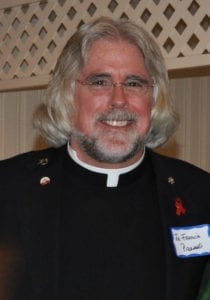
Since I last wrote this column, so much has happened that underscores that we have lost our moral compass. The confirmation process of our most recent Supreme Court Justice was an embarrassment. The behavior on the part of all involved on both sides of the aisle including the White House was reprehensible.
Have we lost all respect for the integrity and dignity of the human person? True leaders lead by personal example and respect. The moral decay has become infectious. The search for the truth has become inconsequential.
Meanwhile, on the home front parents continue to senselessly bury their children of all ages due to the opioid epidemic, and our national health crisis seems to have no real end in sight.
For all the circular rhetoric around this issue, we still have no additional beds for long-term residential treatment. Insurance companies continue to murder our most vulnerable by telling them to try outpatient treatment first; and if they fail, then they will pay for residential care, which for the record is down to less than 11 days!
Those that we have elected to lead us and protect us are clearly uneducated and clueless in regards to the devastation of this epidemic.
One outraged mother met with a group of parents and a local congressional person to voice their concerns for his lack of support on this issue and his support of the insurance industry. One of the mothers spoke out and said: “I did what you told us to do; I tried outpatient treatment for my son and he failed!” She then placed the cremated ashes of her son on his desk. The congressperson said nothing!
Despite all of this negativity, hope continues to give me strength to fight the good fight. On Oct. 20 at the Shoreham Country Club, a band that came together in early recovery did a benefit concert. They were amazing. They are known as the H.I.M.S. (Hope Inspired Men Sing) and Her. It was a refreshing evening of music that was filled with hope, change and transformation. People do recover and reclaim their lives after addiction!
The event was the idea of a retired lawyer from Shoreham who wanted to raise awareness around the affliction of addiction and also raise money that could help the recovery effort that is happening at Hope Academy on the grounds of Little Portion Friary in Mount Sinai. Thanks to her efforts more than $4,000 was raised that night.
On Sunday afternoon, at the dynamic Mount Sinai Congregational Church in Mount Sinai, that community installed a new pastor, the Rev. Phil Holson. The celebration was filled with joy, gratitude and renewed hopefulness.
The Mount Sinai Congregational Church has been a prophetic voice in our midst. As a local faith community, members don’t just talk the talk, they walk the walk!
This is evidenced in their mission statement that is quite inclusive. It states as a congregation they are committed to justice and all are welcome — regardless of age, race, abilities, economic or marital status, gender, sexual orientation or gender identification. They state they are a church that is open and affirming of all people, as we are all made in the image of God.
For almost four decades, I have seen this church community in action. Their commitment to social justice is an inspiration! Welcome Pastor Phil to the neighborhood! Thanks for saying yes — we need another prophetic voice in our midst!
Fr. Pizzarelli, SMM, LCSW-R, ACSW, DCSW, is the director of Hope House Ministries in Port Jefferson.
Medical Compass: Taking control of Type 2 diabetes
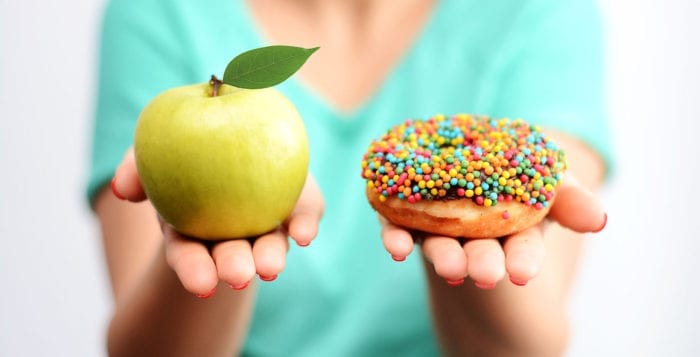
Dietary changes are worth the effort
By David Dunaief, M.D.

Lifestyle modifications are the most effective way to tackle Type 2 diabetes and its complications. Many in the medical community agree that a combination of diet and exercise is the best approach. However, American Diabetes Association (ADA) guidelines recommend that patients with new onset disease start by combining lifestyle changes with the medication metformin.
The thinking behind this approach is that too many patients fail on diet alone, and it’s important to reduce glucose (sugar) levels as soon as possible. According to the guidelines’ authors, for most individuals with Type 2 diabetes, lifestyle interventions fail to achieve or maintain metabolic goals, either because of failure to lose weight, weight regain, progressive disease or a combination of factors (1).
I agree that it is not easy to change your lifestyle, but I also think that, for highly motivated patients, the benefits far outweigh the challenges. Not only can we treat this disease, but we can also prevent its complications, such as heart disease, which are so difficult to treat with medications.
Type 2 diabetes is caused in large part by poor nutrition. Yes, some people have a higher propensity than others, but if compliant on a diet regimen, you can dramatically reduce your risk. And, while medications may help manage diabetes, they also have varying degrees of undesirable side effects. With lifestyle modifications, though, there are only positive effects.
What type of diet regimen may be used to prevent Type 2 diabetes?
The regimen that has achieved the best results is a plant-based diet rich in vegetables, beans and legumes, nuts and seeds, whole grains and fruits. It also may include animal products with an emphasis on fish. This is a diet that emphasizes good fats, those with lots of omega 3 fatty acids, and is low in saturated fat. The data suggest that antioxidants, such as carotenoids, which can be found in multiple foods in this diet, play an integral role in preventing the disease (2).
A randomized clinical trial, called the PREDIMED study, published in the journal Diabetes Care in January 2011, showed that a Mediterranean-type diet, such as described above, reduced the risk of Type 2 diabetes by 52 percent, when compared to a low-fat diet (3). The incredible part was that these results were seen over a short four years, with negligent weight loss among the trial groups. In other words, the Mediterranean-type diet’s effects extend beyond a change in body mass index.
An observational study showed that those with the highest compliance with a Mediterranean-type diet had a dramatic risk reduction for developing diabetes of 83 percent (4).
What about treatment?
A study published in the American Journal of Clinical Nutrition showed a low-fat vegan diet had twice the effectiveness in lowering glucose levels, compared to the traditional ADA diet (5). Both groups lost about the same amount of weight. Again, it shows that there is more than just weight loss involved in effective dietary regimens for this disease.
Can we reverse Type 2 diabetes?
In a study I authored in collaboration with Dr. Joel Fuhrman and the University of Pennsylvania Medical Center, results showed that 62 percent of participants who followed a high-nutrient density diet, similar to the Mediterranean-type diet, achieved normal glycemic (sugar) levels (6). Thus, they became nondiabetic.
Even more impressive, participants were able to reduce the number of overall medications from four to one and discontinue all of their diabetic medications, except for one participant. Of those with high blood pressure, the mean blood pressure was normal at the last data point of the study. There was also significant improvement in the lipid profiles of participants.
These are very positive results for both prevention and treatment of Type 2 diabetes and its complications. The caveat is that it is not easy and takes highly motivated individuals. However, the results are well worth the effort.
References:
(1) Diabetes Care 2018 Jan; 41(Supplement 1): S73-S85. (2) Am J Clin Nutr June 2003 77(6):1434-1441. (3) Diabetes Care 2011(34):14-19. (4) BMJ. 2008 Jun 14;336(7657):1348–1351. (5) Am J Clin Nutr May 2009 89(5):1588S-1596S. (6) Open Jnl Prev Med Aug 2012 2(3):364-371.
Dr. Dunaief is a speaker, author and local lifestyle medicine physician focusing on the integration of medicine, nutrition, fitness and stress management. For further information, visit www.medicalcompassmd.com or consult your personal physician.
Photo of the Week
HAPPY HALLOWEEN!
‘Zoe is ready for Halloween!’ says her Grandma Carol of East Setauket who sent this photo in on Zoe’s behalf.
Send your Photo of the Week to [email protected].
Shelter Pets of the Week: Peter and Lolly
MEET PETER AND LOLLY!
 This week’s shelter pets are the duo of Peter and Lolly, gorgeous 6-month-old kittens waiting patiently at Kent Animal Shelter to start a new chapter in their lives.
This week’s shelter pets are the duo of Peter and Lolly, gorgeous 6-month-old kittens waiting patiently at Kent Animal Shelter to start a new chapter in their lives.
The shelter is offering free kitten adoptions through the month of October. All are spayed/neutered, up to date with vaccines, microchipped and tested negative for feline aids and leukemia before they go home.
Kent Animal Shelter is located at 2259 River Road in Calverton. The adoption center is open from 10 a.m. to 4 p.m. every day. For more information on Peter and Lolly and other adoptable pets at Kent, call 631-727-5731.
Setauket Artists’ Exhibition celebrates 38th year
When autumn arrives, residents of the Three Village area may start to think of the annual fall art show that has become a true community treasure. The Setauket Artists will host its 38th Artists’ Exhibition 2018 from Oct. 28 to Nov. 19 at the Setauket Neighborhood House, 95 Main Street, Setauket.

Over 40 award-winning artists will participate in the show this year including Lana Ballot, Ross Barbara, Shain Bard, Eleanor Berger, Rina Betro, Joan Bloom, Renee Caine, Al Candia, Gail L. Chase, Anthony Davis, Julie Doczi, Jeanette Dick, W.A. Dodge, Marge Governale, Peter Hahn, Melissa Imossi, Laurence Johnston, Anne Katz, Flo Kemp, Karen Kemp, Michael R. Kutzing, John Mansueto, Jane McGraw Teubner, Terry McManus, Eleanor Meier, Fred Mendelsohn, Muriel Musarra, Genia Neuschatz, Iacopo Pasquinelli, Paula Pelletier, Denis Ponsot, Joseph Reboli, Joan Rockwell, Robert Roehrig, Irene Ruddock, Carole Link Scinta, Sungsook Setton, Barbara Jeanne Siegel, Angela Stratton, Mac Titmus, Nancy Weeks, Marlene Weinstein, Laura Westlake and Patricia Yantz.

The exhibition will kick off with an opening reception on Sunday, Oct. 28 from 1 to 4 p.m. All are invited to this free event to enjoy some light refreshments while viewing the beautiful artwork, all of which will be for sale. Take a chance on winning a painting by four Setauket artists, the proceeds of which support the art organization. Marlene Weinstein will offer a photograph titled “Fishing Boat Trio,” John Mansueto will offer an original oil, Muriel Mussara will offer a watercolor titled “Conscience Bay” and Frederic Mendelsohn, this year’s honored artist, will also offer an original oil painting.
For over 10 years, Fred Bryant of Bryant Funeral Home has sponsored the Setauket Artists, allowing this exhibit to be one of the most attended functions in the Three Village area.

This year’s distinguished guest artist is David Peikon, renowned oil painter and winner of many awards throughout the country. Tom Mason, known for his old master paintings and portraiture, will be the distinguished judge.
If you miss the first reception, you will have a chance to meet your favorite artists at the second reception at the annual Wine and Cheese Art Event held on Friday, Nov. 16 from 5 to 7 p.m. Many new paintings will be displayed for the evening, just in time for holiday giving.
“Don’t miss this once-a-year opportunity to attend the receptions or daily viewing to see paintings that are classic and enduring and have given credence to our motto “Art for a lifetime,” said Irene Ruddock, coordinator of the event, adding, “After the exhibit, visit www.SetauketArtists.com to learn about the group’s Art Consultation feature where you may arrange to see paintings in your home before you decide whether or not to purchase them. The paintings of the artists include a wide range of modalities featuring work that is impressionistic, contemporary or traditional, including a portrait artist who will paint the perfect likeness of your loved ones or pet.”
For further information, you may contact Irene Ruddock at [email protected]. or 631-365-1312. For viewing hours at the Setauket Neighborhood House, visit www.setauketartists.com on the Events page.
SBU’s Gábor Balázsi shows temperature affects yeast genes
By Daniel Dunaief
An especially hot July day can send hordes of people to Long Island beaches. A cooler July temperature, however, might encourage people to shop at a mall, catch a movie or stay at home and clean out clutter.
Similarly, genes in yeast respond to changes in temperature.
Gábor Balázsi, the Henry Laufer associate professor of physical and quantitative biology at Stony Brook University, recently published research in the Proceedings of the National Academy of Sciences on the effect of temperature changes on yeast genes.
“We are looking at single cells and at genetic systems and we can dissect and understand gene by gene with a high level of detail,” said Balázsi, who used synthetic genetic systems to allow him to dissect and understand how temperature affects these genes.
 Understanding the basic science of how genes in individual cells respond to temperature differences could have broad applications. In agriculture, farmers might need to know how genes or gene circuits that provide resistance to a pathogen or drought tolerance react when the temperature rises or falls.
Understanding the basic science of how genes in individual cells respond to temperature differences could have broad applications. In agriculture, farmers might need to know how genes or gene circuits that provide resistance to a pathogen or drought tolerance react when the temperature rises or falls.
Similarly, researchers using genetically designed biological solutions to environmental problems, like cleanups at toxic spills, would need to understand how a change in temperature can affect their systems.
Lingchong You, an associate professor of biomedical engineering at Duke University, believes the research is promising.
“Understanding how temperature will influence the dynamics of gene circuits is intrinsically interesting and could serve as a foundation for the future,” You said. Researchers “could potentially design gene circuits to program the cell such that the cell will somehow remember its experience with the fluctuating temperatures,” which could provide clues about the experience of the cell.
Balázsi suggested the goal of his work is to understand the robustness of human control over cells in nonstandard conditions.
While other researchers have explored the effects of gene expression for hundreds of genes at different temperatures, Balázsi looked more precisely at single genes and human-made synthetic gene circuits in individual cells. He discovered various effects by inserting a two-gene circuit into yeast.
At the whole-cell level when temperatures rise from 30°C to 38°C, some cells continued growing, albeit at a slower rate, while others stopped growing and started to consume their proteins.
For the second type of cells, changing temperatures can lead to cell death. If the temperature comes down to normal levels soon enough, however, researchers can rescue those cells.
“How this decision happens is a question that should be addressed in the future,” Balázsi said.
While the dilution of all proteins slows down, the chemical reactions in which they participate speed up at a higher temperature, much like children who become more active after receiving sugar at a birthday party.
At another level, certain individual molecules change their movement between conformations at a higher temperature. Proteins wiggle more between different folding conformations even if they don’t change composition. This affects their ability to bind DNA.
Balázsi said he is fortunate that he works through the Laufer Center for Physical and Quantitative Biology, which partly supported the work, where he was able to find a collaborator to do molecular dynamic simulations. Based on the pioneering experiments of postdoctoral fellow Daniel Charlebois, with help from undergraduate researcher Sylvia Marshall, the team collected data for abnormal behaviors of well-characterized synthetic gene circuits. They worked with Kevin Hauser, a former Stony Brook graduate research assistant, who explained how the altered conformational movements affected how the protein and cells behaved.
The way proteins fold and move between conformations determines what they do.

Photo from Gábor Balázsi
Taking his observations and experiments further, Balázsi found that proteins that were unbound to a small molecule didn’t experience a change in their conformation. When they were linked up, however, they demonstrated a new behavior when heated. This suggests that understanding the effects of temperature on these genetic systems requires an awareness of the proteins involved, as well as the state of their interaction with other molecules.
While Balázsi explored several ways temperature changes affect the yeast proteins, he acknowledged that other levels or forces might emerge that dictate the way these proteins change.
Additionally, temperature changes represent just one of many environmental factors that could control the way the genetic machinery of a cell changes. The pH, or acidity, of a system might also change a gene or group of genes.
A main overarching question remains as to how much basic chemical and physical changes combine with biological effects to give predictable, observable changes in the behaviors of genes and living cells.
Balázsi may test other cell types. So far, he’s only looked at yeast cells. He would also like to know the order in which the various levels of reactions — from the whole cell to the molecular level — occur.
He is interested in cancer research and possibly defense applications and would like to take a closer look at the way temperature or other environmental factors impact human disease processes and progression or think about their relevance for homeland security or biological solutions to renewable energy.
Balázsi recognizes that he and others in this field have numerous hurdles to overcome to find acceptable appreciation for the application of synthetic gene circuits.
“It’s not so simple to engineer these cells reliably,” he said. “Some roadblocks need to be eliminated to convince people it’s feasible and useful.”
Balázsi suggested that the field of virology might benefit from pursuing some of these research questions. Viruses move from the environment or even from other hosts into humans. Avian influenza, for example, can begin inside a bird and wind up affecting people. These viruses “might have different expression patterns in birds versus humans,” he said.
Ultimately, he added, this kind of scientific pursuit is “multipronged and the applications are numerous.”
Young artists thrill and scare with HAC’s Nightmare on Main Street
By Melissa Arnold
An eerie chill is beginning to settle over Long Island, and with it comes the creepy sort of magic that only Halloween can bring. Whether you’re in it for the candy or the costumes, celebrating All Hallows Eve encourages young and old alike to get creative and maybe even spooky.
To celebrate the season, the Huntington Arts Council is sponsoring its 7th annual Nightmare on Main Street at the Main Street Gallery, a juried student art show showcasing some of our area’s most talented young artists.
The exhibit allows students in grades 6 through 12 to submit their favorite Halloween-themed artwork for consideration. In total, 41 artists from Nassau and Suffolk counties were chosen, and more than 85 spooky pieces in varied mediums will be on display.
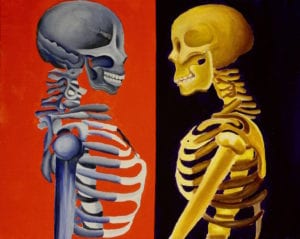
This year’s juror, Jessica “Ratgrrl” Valentin, is primarily a digital and collage artist. Her “heartbreaking pop” style has graced galleries throughout Long Island and New York City. Her latest project, Muñeca Arthouse, is a unique gallery space in Patchogue.
Valentin also played a part in shaping the theme for this year’s exhibit. “I love spooky, but not horror,” she said. “I blend my work with spooky themes, color, and sweetness so I can deal with the things that scare me. How do you face the things that scare you?” she asked, setting the tone for the entries.
Anna Laimo, a senior at Half Hollow Hills High School East, was overjoyed to be chosen for this year’s Nightmare on Main Street, an exhibit she said is a perfect fit for her.
“My dad is a horror novelist, and I grew up watching scary movies with him. I love everything about the horror industry,” said the 17-year-old. “I submitted a few pieces for the exhibit last year but I wasn’t chosen, so it feels great to know I’ve improved this year.”
Laimo’s submissions include “Complement Me,” an acrylic and oil painting of skeletons on a date, and “Swell,” a drawing based on another interest of hers — special effects makeup.
North Babylon High School senior Zoe Hartmann is also making her debut at the exhibit this year thanks to an art class assignment. “My teacher had all of us do a Halloween-themed piece to submit. I was really surprised and excited when I found out I was picked. This is my first juried exhibit,” said Hartmann, 17.
Her contribution, a colored pencil drawing called “Rise of the Dead,” depicts a female skeleton alone in a cemetery. Hartmann said that she was inspired by the 2017 Disney-Pixar film, “Coco,” and the idea that, eventually, the dead are forgotten.
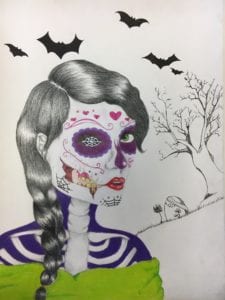 Along with Laimo and Hartmann, the works of Olivia Belluomo, Brooke Blumberg, Sage Boiko, Grace Burkart, Giavanna Castro, Ziqian Chen, Maxwell DeFalco, Alysse Fazal, Gloria Gang, Rachel Taylor Goldsmith, Elizabeth Gordin, Jenna Hart, Morgan Hlaing, Jiayi Huo, Evelyn Johnson, Aya Karimealaoui, Evgenia Kennedy, Siyu Lei, Juliette Liberatoscioli, Angelina Lomangino, Jessica Lyle, Sara Madsen, Chase McGill, Madalyn Metzger, Frida Misko, Benjamin Pollard, Sophia Polizzi, Dylan Roca, Matthew Rubenfeld, Jessica Rush, Mehr Sharma, Martina Simone, Juliah Triana, Leia Ulrich, Anna Vig, Emily Villavicencio, Isabelle Waldorf, Hephzibah Yoo and Ida Zuo will also be on view.”
Along with Laimo and Hartmann, the works of Olivia Belluomo, Brooke Blumberg, Sage Boiko, Grace Burkart, Giavanna Castro, Ziqian Chen, Maxwell DeFalco, Alysse Fazal, Gloria Gang, Rachel Taylor Goldsmith, Elizabeth Gordin, Jenna Hart, Morgan Hlaing, Jiayi Huo, Evelyn Johnson, Aya Karimealaoui, Evgenia Kennedy, Siyu Lei, Juliette Liberatoscioli, Angelina Lomangino, Jessica Lyle, Sara Madsen, Chase McGill, Madalyn Metzger, Frida Misko, Benjamin Pollard, Sophia Polizzi, Dylan Roca, Matthew Rubenfeld, Jessica Rush, Mehr Sharma, Martina Simone, Juliah Triana, Leia Ulrich, Anna Vig, Emily Villavicencio, Isabelle Waldorf, Hephzibah Yoo and Ida Zuo will also be on view.”
Prizes were awarded in two categories: grades 6 to 8 and 9 to 12. In the junior division, Best in Show went to Frida Misko for “Spooky But Sweet” with Angelina Lomangino receiving an Honorable Mention for “Wick.” In the senior division, Sage Boiko won Best in Show for “Werewolf of Wysteria” while Honorable Mentions were awarded to Anna Laimo’s “Complement Me” and Siyu Lei’ “This Red or This One.”
“I was honored and excited to be chosen as a juror,” said Valentin. “It was surprising; the layered complexity and the technical skill of these young artists. I love the places that they took the theme. It was hard. There was lots of good work to choose from.”
“Nightmare on Main Street continues to receive an incredible response from the student artists who enter the show as well as the surrounding community,” said Huntington Arts Council Executive Director Marc Courtade. “The artwork featured in this exhibit reflects an incredible level of talent.We are always thrilled to see the work of young adults in our gallery.”
Nightmare on Main Street will be on display through Nov. 3 at the Main Street Gallery, 213 Main St., Huntington. A costume reception will be held on Oct. 26 from 6 to 8 p.m. at the gallery, where prizes will be awarded to select artists and for best costume. All are welcome. Refreshments will be served. For information, call 631-271-8423 or visit www.huntingtonarts.org.



